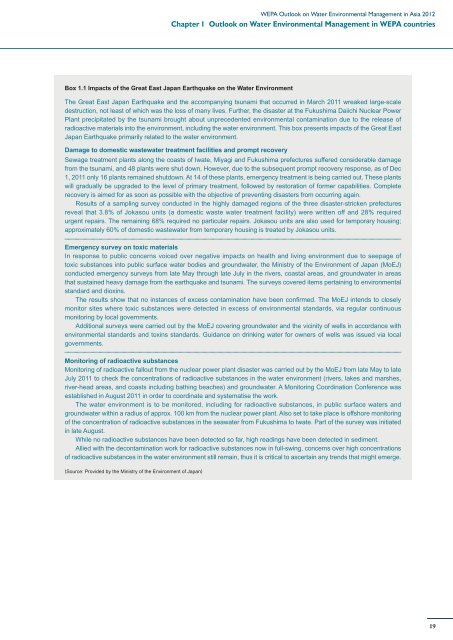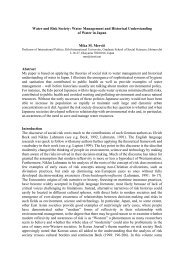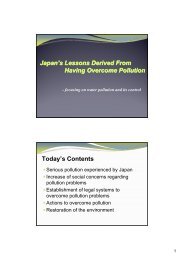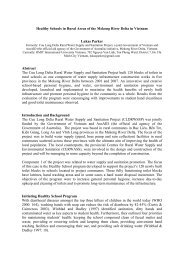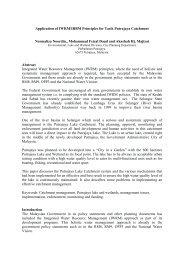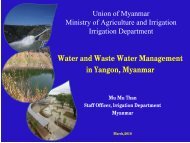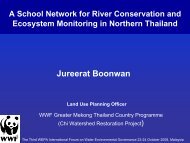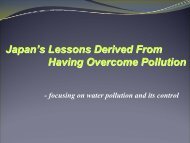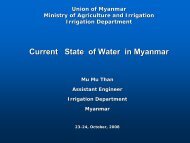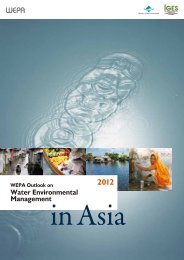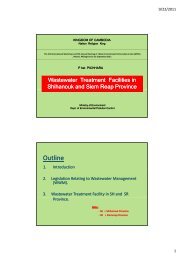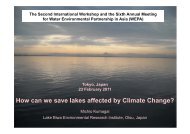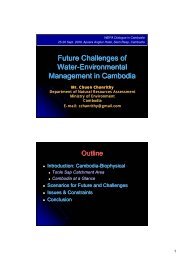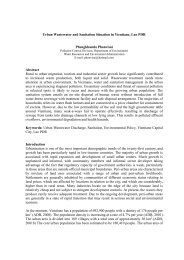WEPA Outlook on Water Environmental Management in Asia 2012
WEPA Outlook on Water Environmental Management in Asia 2012
WEPA Outlook on Water Environmental Management in Asia 2012
Create successful ePaper yourself
Turn your PDF publications into a flip-book with our unique Google optimized e-Paper software.
<str<strong>on</strong>g>WEPA</str<strong>on</strong>g> <str<strong>on</strong>g>Outlook</str<strong>on</strong>g> <strong>on</strong> <strong>Water</strong> Envir<strong>on</strong>mental <strong>Management</strong> <strong>in</strong> <strong>Asia</strong> <strong>2012</strong>Chapter 1 <str<strong>on</strong>g>Outlook</str<strong>on</strong>g> <strong>on</strong> <strong>Water</strong> Envir<strong>on</strong>mental <strong>Management</strong> <strong>in</strong> <str<strong>on</strong>g>WEPA</str<strong>on</strong>g> countriesBox 1.1 Impacts of the Great East Japan Earthquake <strong>on</strong> the <strong>Water</strong> Envir<strong>on</strong>mentThe Great East Japan Earthquake and the accompany<strong>in</strong>g tsunami that occurred <strong>in</strong> March 2011 wreaked large-scaledestructi<strong>on</strong>, not least of which was the loss of many lives. Further, the disaster at the Fukushima Daiichi Nuclear PowerPlant precipitated by the tsunami brought about unprecedented envir<strong>on</strong>mental c<strong>on</strong>tam<strong>in</strong>ati<strong>on</strong> due to the release ofradioactive materials <strong>in</strong>to the envir<strong>on</strong>ment, <strong>in</strong>clud<strong>in</strong>g the water envir<strong>on</strong>ment. This box presents impacts of the Great EastJapan Earthquake primarily related to the water envir<strong>on</strong>ment.Damage to domestic wastewater treatment facilities and prompt recoverySewage treatment plants al<strong>on</strong>g the coasts of Iwate, Miyagi and Fukushima prefectures suffered c<strong>on</strong>siderable damagefrom the tsunami, and 48 plants were shut down. However, due to the subsequent prompt recovery resp<strong>on</strong>se, as of Dec1, 2011 <strong>on</strong>ly 16 plants rema<strong>in</strong>ed shutdown. At 14 of these plants, emergency treatment is be<strong>in</strong>g carried out. These plantswill gradually be upgraded to the level of primary treatment, followed by restorati<strong>on</strong> of former capabilities. Completerecovery is aimed for as so<strong>on</strong> as possible with the objective of prevent<strong>in</strong>g disasters from occurr<strong>in</strong>g aga<strong>in</strong>.Results of a sampl<strong>in</strong>g survey c<strong>on</strong>ducted <strong>in</strong> the highly damaged regi<strong>on</strong>s of the three disaster-stricken prefecturesreveal that 3.8% of Jokasou units (a domestic waste water treatment facility) were written off and 28% requiredurgent repairs. The rema<strong>in</strong><strong>in</strong>g 68% required no particular repairs. Jokasou units are also used for temporary hous<strong>in</strong>g;approximately 60% of domestic wastewater from temporary hous<strong>in</strong>g is treated by Jokasou units.Emergency survey <strong>on</strong> toxic materialsIn resp<strong>on</strong>se to public c<strong>on</strong>cerns voiced over negative impacts <strong>on</strong> health and liv<strong>in</strong>g envir<strong>on</strong>ment due to seepage oftoxic substances <strong>in</strong>to public surface water bodies and groundwater, the M<strong>in</strong>istry of the Envir<strong>on</strong>ment of Japan (MoEJ)c<strong>on</strong>ducted emergency surveys from late May through late July <strong>in</strong> the rivers, coastal areas, and groundwater <strong>in</strong> areasthat susta<strong>in</strong>ed heavy damage from the earthquake and tsunami. The surveys covered items perta<strong>in</strong><strong>in</strong>g to envir<strong>on</strong>mentalstandard and diox<strong>in</strong>s.The results show that no <strong>in</strong>stances of excess c<strong>on</strong>tam<strong>in</strong>ati<strong>on</strong> have been c<strong>on</strong>firmed. The MoEJ <strong>in</strong>tends to closelym<strong>on</strong>itor sites where toxic substances were detected <strong>in</strong> excess of envir<strong>on</strong>mental standards, via regular c<strong>on</strong>t<strong>in</strong>uousm<strong>on</strong>itor<strong>in</strong>g by local governments.Additi<strong>on</strong>al surveys were carried out by the MoEJ cover<strong>in</strong>g groundwater and the vic<strong>in</strong>ity of wells <strong>in</strong> accordance withenvir<strong>on</strong>mental standards and tox<strong>in</strong>s standards. Guidance <strong>on</strong> dr<strong>in</strong>k<strong>in</strong>g water for owners of wells was issued via localgovernments.M<strong>on</strong>itor<strong>in</strong>g of radioactive substancesM<strong>on</strong>itor<strong>in</strong>g of radioactive fallout from the nuclear power plant disaster was carried out by the MoEJ from late May to lateJuly 2011 to check the c<strong>on</strong>centrati<strong>on</strong>s of radioactive substances <strong>in</strong> the water envir<strong>on</strong>ment (rivers, lakes and marshes,river-head areas, and coasts <strong>in</strong>clud<strong>in</strong>g bath<strong>in</strong>g beaches) and groundwater. A M<strong>on</strong>itor<strong>in</strong>g Coord<strong>in</strong>ati<strong>on</strong> C<strong>on</strong>ference wasestablished <strong>in</strong> August 2011 <strong>in</strong> order to coord<strong>in</strong>ate and systematise the work.The water envir<strong>on</strong>ment is to be m<strong>on</strong>itored, <strong>in</strong>clud<strong>in</strong>g for radioactive substances, <strong>in</strong> public surface waters andgroundwater with<strong>in</strong> a radius of approx. 100 km from the nuclear power plant. Also set to take place is offshore m<strong>on</strong>itor<strong>in</strong>gof the c<strong>on</strong>centrati<strong>on</strong> of radioactive substances <strong>in</strong> the seawater from Fukushima to Iwate. Part of the survey was <strong>in</strong>itiated<strong>in</strong> late August.While no radioactive substances have been detected so far, high read<strong>in</strong>gs have been detected <strong>in</strong> sediment.Allied with the dec<strong>on</strong>tam<strong>in</strong>ati<strong>on</strong> work for radioactive substances now <strong>in</strong> full-sw<strong>in</strong>g, c<strong>on</strong>cerns over high c<strong>on</strong>centrati<strong>on</strong>sof radioactive substances <strong>in</strong> the water envir<strong>on</strong>ment still rema<strong>in</strong>, thus it is critical to ascerta<strong>in</strong> any trends that might emerge.(Source: Provided by the M<strong>in</strong>istry of the Envir<strong>on</strong>ment of Japan)19


